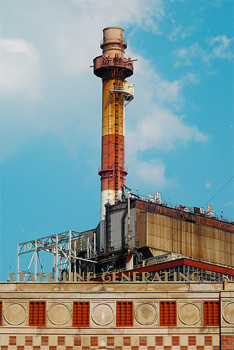Coal Collapse in Chicagoland
By JoshMogerman in News on May 7, 2011 7:00PM
In October, The Reader ran a feature story examining the possibility of "Chicago Without Coal" in the coming years. But only six months later, dramatic events throughout the region seem to be moving up the time-line on the questions the story raised. The announcement this week that the State Line Power Station could close as soon as next year, paired with recent announcements in NW Indiana and Milwaukee, as well as growing support for the Clean Power Ordinance in the City Council seems to reinforce the idea that the little black rocks' days are numbered in our neck of the woods.
Facing federal enforcement and lawsuits from local clean air advocates, Virginia-based Dominion Resources had already announced that the State Line plant's days were numbered. But this week's announcement speeds up the time-line from a 2017 closure to an end no later than 2014. Chicago is one of the chief recipients of the pollution coming out of State Line's stacks, given its unique location on a spit of land in Lake Michigan that is the northernmost territory for the State of Indiana -- though Hoosiers cannot access it by road without driving through Chicago. As Dominion execs signal that they would rather shutter the plant than invest in modern environmental controls to protect neighboring communities to the standard of the Clean Air Act, the Natural Resources Defense Council's Ann Alexander likely summed up the perspective of many when she told WBEZ's NW Indiana correspondent Mike Puente:
That plant is really the poster child for a much larger problem with dirty coal plants in the region and around the nation. It is belching all kinds of pollutants we can easily control. It needed to either clean up or shut down. Shutting down is a very good option.
And it looks like we will see a reduction of pollution coming from our north and south. The State Line closure will follow on the heals of a recent NIPSCO settlement with US EPA which will close another aging coal plant in Gary while modernizing anti-pollution technologies on others in the area -- one of which had been among the nation's worse emitters of lung-wrecking nitrogen oxide. As for State Line, it is one of the nation’s worst emitters of three different pollutants. The Trib reports, "the plant emits more lung-damaging nitrogen oxide than two other former ComEd plants in Chicago [Fisk and Crawford], and churns more smog-forming sulfur dioxide and toxic mercury into the air than either plant." To the north, We Energies announced this week that it would shift a downtown Milwaukee coal plant to natural gas.
Closer to home, the Clean Power Ordinance seems to be stumbling in the waning days of the Daley administration, though its backers are confident that it will move under new Mayor Rahm Emanuel. But anti-pollution boosters notched another win as an ordinance to lower lead levels in Chicago’s air advanced under the shadow of recent news of alarming spikes of the heavy metal in the air around Pilsen’s Perez School.
Should the Clean Power Ordinance pass, many believe that the Fisk and Crawford coal plants in Chicago would likely go the way of their sister plant, State Line, for many of the same economic and technology reasons. Illinois is a net exporter of electricity, making the departure of these aging plants more likely since we do not rely on them to power the region. On a hopeful note, the Trib notes, “Illinois alone added 500 megawatts of pollution-free wind power in 2010, about the same amount generated by the 515-megawatt State Line plant.”
